Thousands of products and services are released every day into the market nowadays. Every product claims to be better than its competitors. Each version claims to be better than its previous one.
Why is that so?
The reason is the difference between what customers want and what companies offer. Understanding customers’ needs and designing your product is a very complex task.
Customer requirements are a complex mixture of many requirements and are often contradictory. It is important for businesses to map what these needs are, which ones they would like to cover, and prioritize which one they want to solve first. And what to solve at all — this also means market positioning — pick your audience and fulfill their needs primarily.
To do this task systematically, the Value Proposition Canvas came into place.
In this article you’ll learn:
- What the value proposition canvas is
- How you can fill out the VPC
- When you should use the Canvas
- Some insider tips, to make sure you use the Canvas properly
Let’s dive in.
What Is the Value Proposition Canvas?
The Value Proposition Canvas focuses on understanding customers’ problems and producing products or services that solve them.
Telling people you have a great product doesn’t make them want it.
You can produce an awesome product with all the bells and whistles, but if it fundamentally doesn’t help customers, or you don’t explain the value clearly, they won’t buy it.
“In the factory we make products, in the drugstore we sell hope.” Charles Revson – Founder of Revlon
The WHY is missing? Understanding why customers buy is at the heart of the value proposition canvas.
What is the benefit of the Value Proposition Canvas?
Value Proposition Canvas is critical to a business model. It helps the business in decision making and positioning of the product. It is more than just a graphical representation of customer wants. Businesses can align their strategies according to customer needs. This can help to produce a product which customers want. Let’s see the most important advantages of the Value Proposition Canvas.
Focused Planning
With new ideas flowing in every minute, it is easy to lose focus on the core values. As a result, the developed product does not fulfill customer expectations. This is not the outcome you wish to achieve. A Value Proposition Canvas acts as a visual guide. It ensures a targeted approach to developing a high demand product.
Improves Marketing Outreach
Launching a new product involves a lot of effort in marketing and branding. It involves informing the customers how buying the product satisfies their needs. This helps build a strong brand image in the minds of consumers. Soon customers start to recognize the brand for the quality and service provided. A Value Proposition Canvas is a useful tool here. It identifies customer needs and develops an action plan for it. With this ensured, promotion and advertisement capture customer attention with ease.
Strong Customer Involvement
Customer orientation is the key to engage customers with your brand and product. Through this approach customer satisfaction is the most important factor in product development. A Value Proposition Canvas links together the identification and fulfillment of needs. The benefit of this framework is that it allows you to focus on elements that customers value the most. Thus, establishing strong customer involvement.
Practical and Simple
Customer Value Canvas gives a simplified overview of the functionality of the business. Analyzing the product strategy and performance becomes comprehensive yet simple.
Value Proposition Canvas structure
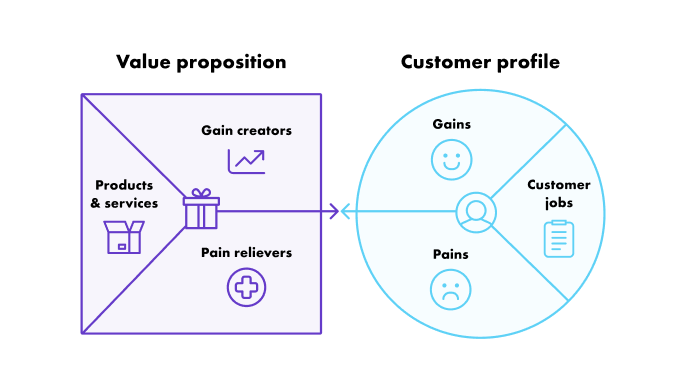
A superficial look and you might think it’s just a piece of paper with a leftward square and rightward circle. These two shapes represent the value proposition and customer. They both help to understand your market needs and how you can best deliver. Now let’s discuss this in detail.
The Customer Profile
The circle represents the customer profile. Generally, here’s where you should start.
The circle is further divided into three parts: jobs, pains, and gains.
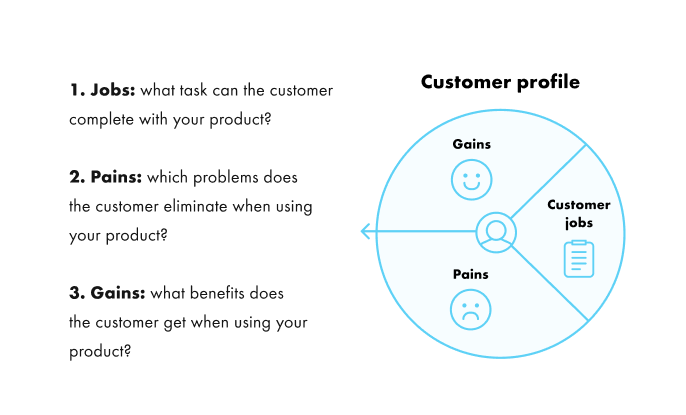
This trio enables you to think from the end-user perspective when defining tasks, challenges and desires they’ll have. Let’s see each part in more detail:
Jobs
Jobs include all the tasks that customers are trying to solve. These jobs can include anything that a customer is trying to do. It can include a problem being solved, a task being achieved, or any other need they want to satisfy.
Jobs can be social, emotional, and functional.
Social jobs are motivated by our societal duty, optimism, fear, or aspiration – the things we feel we have to do as part of our role in relationships and society. For example, when buying a car a social job would be to represent your social status.
Functional jobs are in simple words practical jobs. An example of this would be driving from point A to B.
Emotional jobs come from our preferences, likes and dislikes, and insecurities. With buying a car it would be the feeling we want to get when driving the car.
Here are some questions to help you define customer jobs:
- What functions does your customer try to perform? (for example, execute specific problem, solve a specific issue, etc.)
- What social goals does your customer try to accomplish?
- What are your client’s emotional goals?
- What jobs make them feel satisfied?
- How do your customers want to be perceived by others? What can they do to achieve this?
- How does your customer want to feel? What does he/she need to do to get this?
- Track the interaction of the customer with your product throughout the cycle of consumption. What works should the customer do for this time?
Pains
All factors which stop customers from completing a job are called pains. Imagine them as roadblocks that customers have to deal with. Pains also include negative outcomes that customers prefer to avoid. You can categorize pains as severe or light, which will help to prioritize in the coming steps. This step helps to identify problems from a customer perspective.
Here are some questions to help you define customer pains:
- What does your customer find too costly? (Something that requires a lot of time, costs too much money, it takes a lot of efforts, etc.)
- What makes him/her feel bad?
- What are the current solutions that do not suit your customers?
- What are the main challenges and problems your customer faces? (A lack of understanding of how things work, the difficulties with implementation, etc.)
- What negative social consequences does the customer face or fear to face? (Loss of reputation, credibility, trust, social status, and so on).
- What risks does your customer fear? (financial, social, technical, etc.)
Gains
Gains include the positive experiences and desires that the customers wish to achieve. Gains can be ordinary or even existential. However, gains aren’t the opposite of pains. They are aspects that encourage users to adopt a product or service.
Here are some questions to help you define customer gains:
- What makes your customer happy? (Time, money, efforts, etc.)
- What results does your customer expect, and what can surpass these expectations?
- What would simplify the work or life of your customer? (More services, lower cost, new features, etc.)
- What positive social consequences does your customer want to get?
- What are they looking for? (A smart design, guarantees, specific features, etc.)
The Value Map
The square on the canvas represents the value proposition map. Like the circle, this is also divided into three parts.
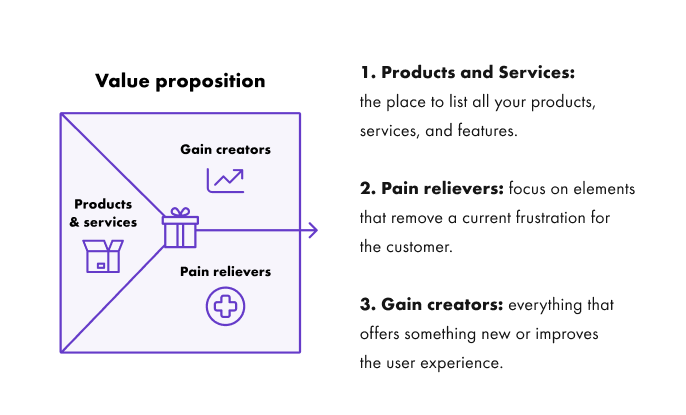
Each part relates to the relevant customer profile section. The focus here is to map out the product features, functionality and benefits that attract customers and fulfill their needs from the circle. Now let’s discuss this in detail.
Products and Services
This is the place to list all the features, products and services you’ll provide. You can also list the version of the product you are producing, like freemium, trial. Focus on how the features and products will help customers get their job done.
Pain relievers
Here the focus is on how your product will ease the customers’ pain. These relievers should be relevant to the pains mentioned in the customer profile. Different sort of pain relievers are made for different kinds of pain. However, it isn’t necessary to discuss the whole pain in detail here. Just a simple statement can do the task.
Here are some questions to help you define customer pain relievers:
- Does your product/ service provide savings? (Regarding time, money, efforts, etc.)
- Does it improve the emotional state of your customer? (Decrease grief, irritation, things that bring a headache).
- Does it fix the defects of existing solutions?
- Does it remove the difficulties or problems that your customer faces?
- Does your product/ service exclude the negative social consequences that are encountered or which are afraid of your customers?
- Does it reduce the risks that your clients are afraid of?
- Does it help your customers sleep better at night?
- Does it limit or eradicate common mistakes that customers allow?
- Does it eliminate barriers that keep your customers from implementing the specific solution?
Gain creators
This is where you show how your product adds value to customers. How does your product help customers achieve their goals? List everything that offers something new or improves the user experience.
Here are some questions to help you define customer gains creators:
- Does your product provide savings that make your client happy?
- Does it ensure the results that the customer expects?
- Does it simplify the work or life of the customer?
- Does it give something that your customer wants to get?
- Does your product/ service reflect some of the dreams of your customer?
- Does it give positive results that meet the criteria for success and failure of the customer?
How to Fill the Value Proposition Canvas
- Choose a customer segment.
- Identify their jobs and prioritize them according to how important they are to your customer.
- Identify pains and prioritize them.
- Identify their gains and prioritize them.
- Pick the top 3-5 most important pains and gains that relate to the most important jobs.
- List all the benefits of your product or service.
- List all pain relievers.
- List of gain creators.
- Pick 3-5 of the gain creators and pain relievers, that make the biggest difference to your customer.
- Link the pain relievers, gain creators and product benefits to the pains, gains and jobs they solve.
- Define how you’re better than the competition.
- Create various value propositions that are clear and free of jargon and that builds trust with your customers.
- Test your value proposition(s) with your customers.
When to Use the Value Proposition Canvas
Now you have a pretty good idea of what the Value Proposition Canvas is. You know what it does and how it operates. You have studied all the different sections and their functionality.
But in what business situation it is truly useful?
Creating a new feature
You can use the VPC when you are planning to develop a new feature for an existing product. Since it helps you understand your audience and their problems, you can get a grip on if the feature will solve any problem or create gain for the users.
Entering a new market or customer segment
Another application can be when you are looking to expand into a new market. Filling out the canvas can help you see if the market really needs you or not. You also understand the service you are offering and the current customer problems. This can help you in making a sound decision.
Test product-market fit
Value Proposition Canvas can help you in finding the best product-market fit. It helps you to understand your market and develop a product to meet their real needs. Matches between customer profile and value proposition indicate a product-market fit, which will increase your chances of success.
Write value propositions
You can use the canvas for creating value propositions, that you base on the value map. This way you can reach out to customers focusing on product benefits, rather than product features.
Taking into account the functional, emotional and social jobs the customers face, you can craft a value proposition that triggers emotion.
A Value Proposition Canvas lets you map out your customer and your product, to see what is motivating them. You can find new ways to pitch what you sell, as well as identifying new customers who might like you for different reasons.
When you can draw a connection between a motivated customer and the reason for buying your products, you have a Value Proposition, one which can be tested and validated.
Refine your marketing strategy
When we did value proposition canvas for our product Freebees.io we realized that we had two completely different customers.
Customers who we tried to reach with the same tactics and messages for months. Asking about pains and gains, led us to realize we had some bad assumptions about our market.
This led to separating our marketing strategy to have HR and CEO target groups. We couldn’t market to them the same way, since the things they valued and needed were very different. To cover the whole market, we needed to tune our messages and value props to our customers.
Your marketing strategy isn’t created from the value proposition canvas, it’s informed by it. But this information can help you see your marketing in a whole new light.
TIPS for using the Value Proposition Canvas
View each component
Components of Value Proposition Canvas are unique yet correlated. Customer Profile is about observing the customer needs and wants. The Value Map is integrating those key findings to improve product quality. How to turn the final product into what the customers’ desire is within the powers of the business. To achieve this, make sure to address customer requirements.
Deal every customer segment
This is the most common error done by businesses. Each customer segment is distinct in its jobs, pain, and gains. It is a mistake to squeeze all of them together into one Customer Profile. Why? This makes it difficult for businesses to assess which target segment to address.
A tip is to make separate Customer Profiles for each customer segment. This gives you the option to devise value propositions for every segment separately. So choosing a customer segment to focus on is much easier.
Think like a customer
A customer profile must represent jobs, pains, and gains that a customer wishes to achieve. Most businesses draft customer profiles inefficiently. They fail to focus on what customers expect from a given product. They tend to only see what their product (or service) is set to resolve when launched into the market.
What you can do is ask all the team to switch roles and pretend to be customers. Think about their day: what are they doing? Where are they going? What tools are they using? Once you start thinking like a customer, you will be able to see where your product is lacking. Try to figure out what drives a customer to buy a product. What are the essential customer needs that must be satisfied? Use problem-solving tools such as ‘Five Whys‘.
Evaluate Jobs-to-be-done
Know your customers’ job-to-be-done to develop a successful value proposition. This factor differentiates on how deeply a product is desired compared to another. While functional jobs tend to be the most obvious reason to buy, their level of satisfaction is low. On the other hand, emotional and social jobs give more personal satisfaction. So, plan to develop a product (or service) that caters to social and emotional jobs.
Focus on what customers need the most
Before developing the Value Proposition Map you must keep in mind the following. Not all customer pains and gains can be addressed. The best approach is to target key factors that customers consider as the topmost priority. This will help your team concrete goals to focus on while developing the product.
WRAP UP
Value Proposition Canvas is a great tool for businesses and product teams. You can analyze your strategies and improve your products. It helps you to understand your market and product. It encourages you to ask questions which you normally don’t. You’ll understand why you are developing a product in the first place. This can help you to achieve a better fit between product and market.


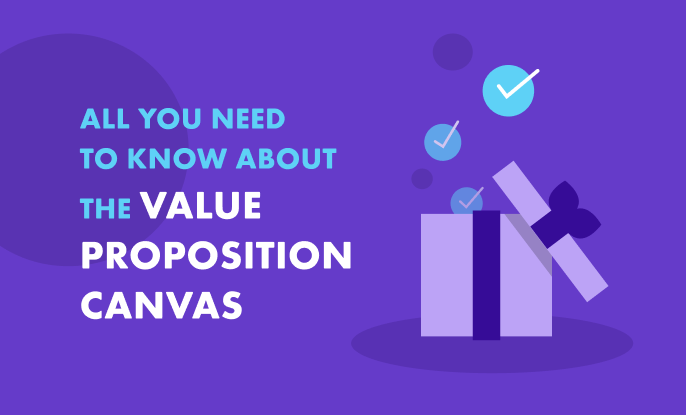

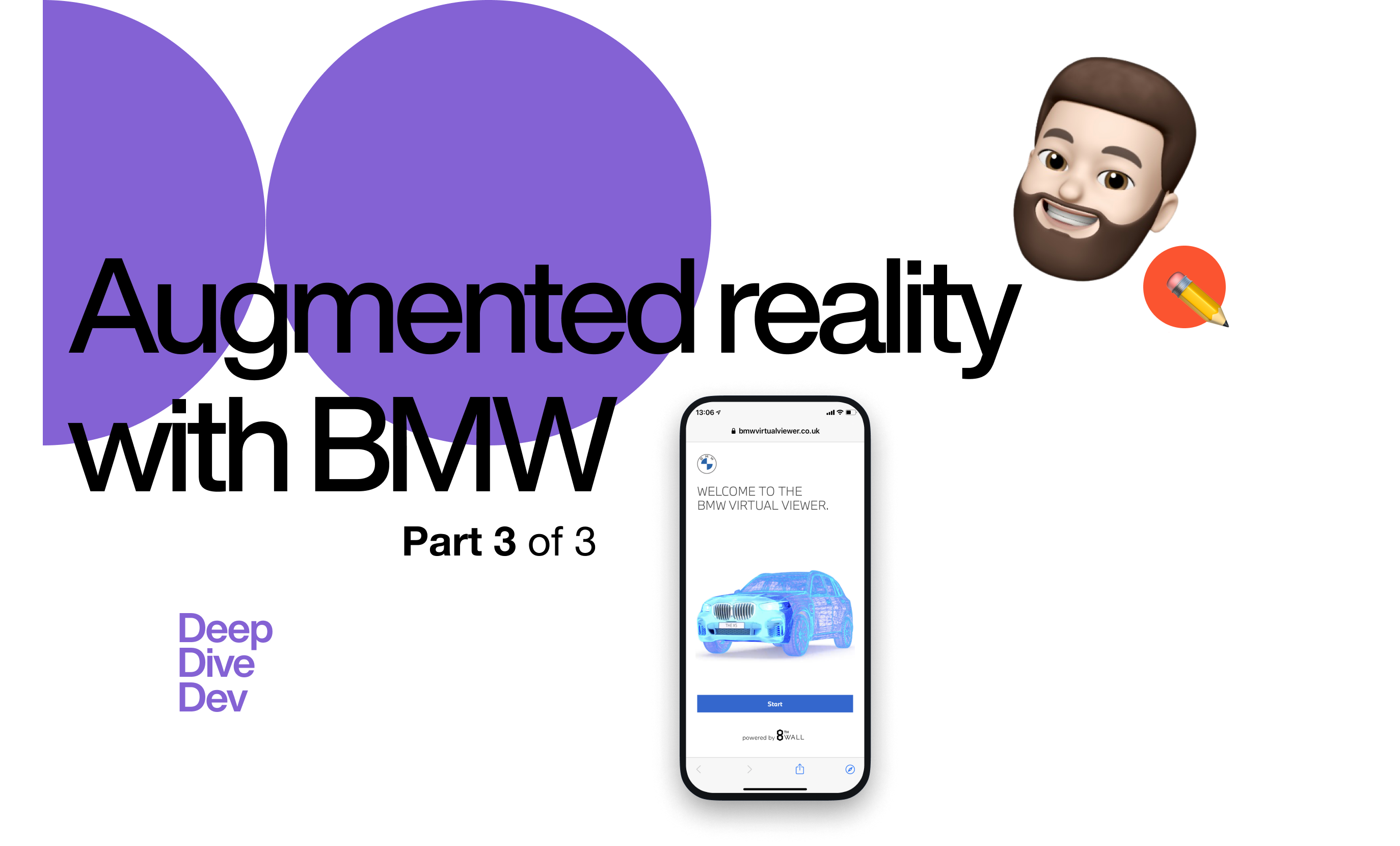
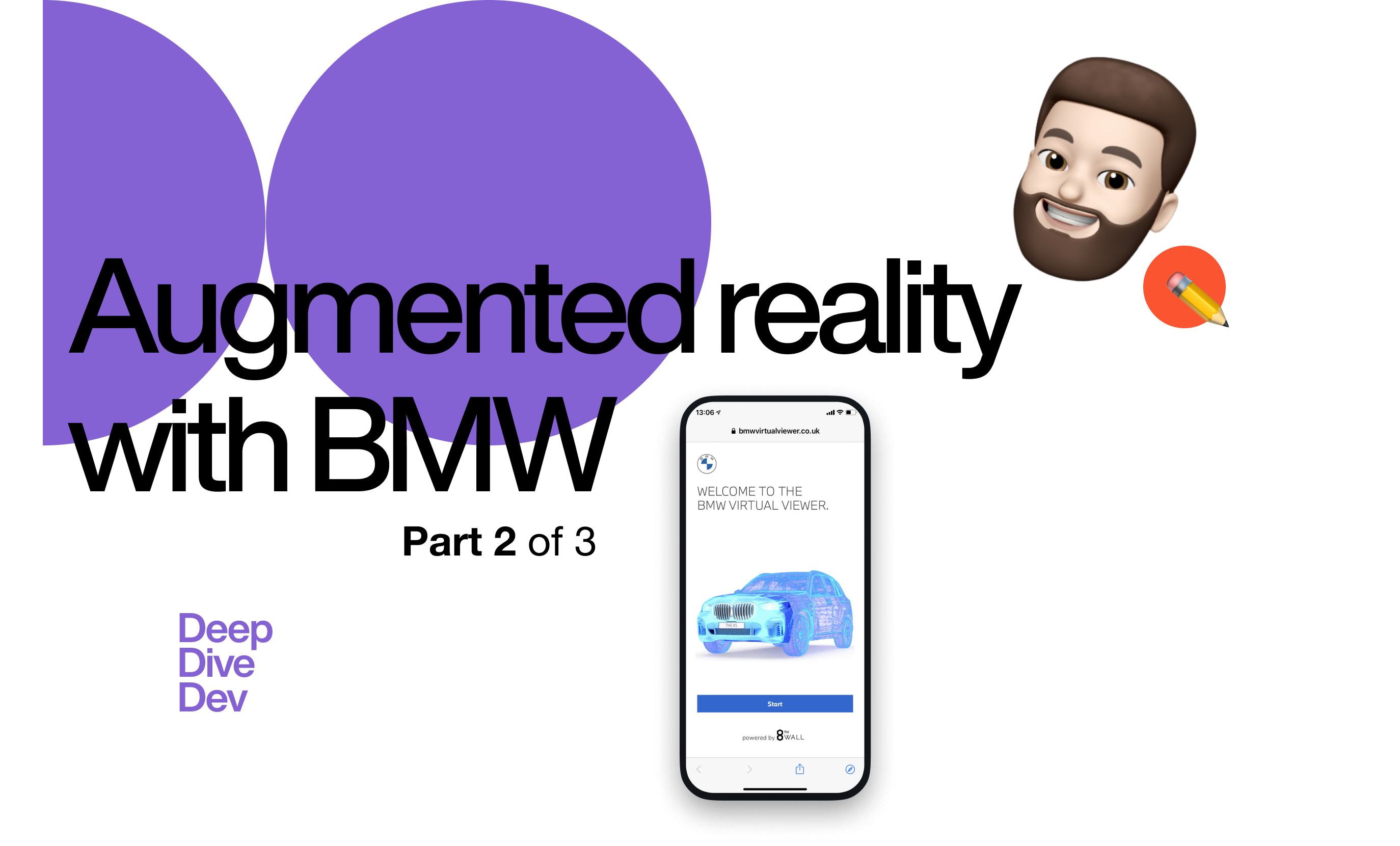
Have a look at our social media